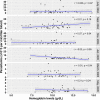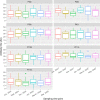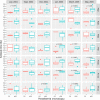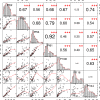Antigenicity and immune correlate assessment of seven Plasmodium falciparum antigens in a longitudinal infant cohort from northern Ghana
- PMID: 31197225
- PMCID: PMC6565625
- DOI: 10.1038/s41598-019-45092-4
Antigenicity and immune correlate assessment of seven Plasmodium falciparum antigens in a longitudinal infant cohort from northern Ghana
Abstract
The current global malaria control and elimination agenda requires development of additional effective disease intervention tools. Discovery and characterization of relevant parasite antigens is important for the development of new diagnostics and transmission monitoring tools and for subunit vaccine development. This study assessed the natural antibody response profile of seven novel Plasmodium falciparum pre-erythrocytic antigens and their potential association with protection against clinical malaria. Antigen-specific antibody levels in plasma collected at six time points from a longitudinal cohort of one-to-five year old children resident in a seasonal malaria transmission area of northern Ghana were assessed by ELISA. Antibody levels were compared between parasite-positive and parasite-negative individuals and the association of antibody levels with malaria risk assessed using a regression model. Plasma antibody levels against five of the seven antigens were significantly higher in parasite-positive children compared to parasite-negative children, especially during low transmission periods. None of the antigen-specific antibodies showed an association with protection against clinical malaria. The study identified five of the seven antigens as markers of exposure to malaria, and these will have relevance for the development of disease diagnostic and monitoring tools. The vaccine potential of these antigens requires further assessment.
Conflict of interest statement
The authors declare no competing interests.
Figures





Similar articles
-
Plasmodium falciparum immunodominant IgG epitopes in subclinical malaria.Sci Rep. 2020 Jun 10;10(1):9398. doi: 10.1038/s41598-020-66384-0. Sci Rep. 2020. PMID: 32523082 Free PMC article.
-
Antibody levels to multiple malaria vaccine candidate antigens in relation to clinical malaria episodes in children in the Kasena-Nankana district of Northern Ghana.Malar J. 2011 May 1;10:108. doi: 10.1186/1475-2875-10-108. Malar J. 2011. PMID: 21529376 Free PMC article.
-
Seroprevalence of Antibodies against Plasmodium falciparum Sporozoite Antigens as Predictive Disease Transmission Markers in an Area of Ghana with Seasonal Malaria Transmission.PLoS One. 2016 Nov 22;11(11):e0167175. doi: 10.1371/journal.pone.0167175. eCollection 2016. PLoS One. 2016. PMID: 27875594 Free PMC article. Clinical Trial.
-
Variations in the quality of malaria-specific antibodies with transmission intensity in a seasonal malaria transmission area of Northern Ghana.PLoS One. 2017 Sep 25;12(9):e0185303. doi: 10.1371/journal.pone.0185303. eCollection 2017. PLoS One. 2017. PMID: 28945794 Free PMC article.
-
Natural antibody responses to Plasmodium falciparum MSP3 and GLURP(R0) antigens are associated with low parasite densities in malaria patients living in the Central Region of Ghana.Parasit Vectors. 2017 Aug 23;10(1):395. doi: 10.1186/s13071-017-2338-7. Parasit Vectors. 2017. PMID: 28835262 Free PMC article.
Cited by
-
How to Accelerate Early Stage of Malaria Vaccine Development by Optimizing Functional Assays.Vaccines (Basel). 2024 May 28;12(6):586. doi: 10.3390/vaccines12060586. Vaccines (Basel). 2024. PMID: 38932315 Free PMC article. Review.
-
Plasmodium falciparum immunodominant IgG epitopes in subclinical malaria.Sci Rep. 2020 Jun 10;10(1):9398. doi: 10.1038/s41598-020-66384-0. Sci Rep. 2020. PMID: 32523082 Free PMC article.
References
-
- WHO. Global technical strategy for malaria 2016–2030. WHO Press (2015).
Publication types
MeSH terms
Substances
Grants and funding
LinkOut - more resources
Full Text Sources

